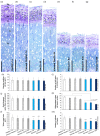The BOP-type co-transcriptional regulator NODULE ROOT1 promotes stem secondary growth of the tropical Cannabaceae tree Parasponia andersonii
- PMID: 33735477
- PMCID: PMC9543857
- DOI: 10.1111/tpj.15242
The BOP-type co-transcriptional regulator NODULE ROOT1 promotes stem secondary growth of the tropical Cannabaceae tree Parasponia andersonii
Abstract
Tree stems undergo a massive secondary growth in which secondary xylem and phloem tissues arise from the vascular cambium. Vascular cambium activity is driven by endogenous developmental signalling cues and environmental stimuli. Current knowledge regarding the genetic regulation of cambium activity and secondary growth is still far from complete. The tropical Cannabaceae tree Parasponia andersonii is a non-legume research model of nitrogen-fixing root nodulation. Parasponia andersonii can be transformed efficiently, making it amenable for CRISPR-Cas9-mediated reverse genetics. We considered whether P. andersonii also could be used as a complementary research system to investigate tree-related traits, including secondary growth. We established a developmental map of stem secondary growth in P. andersonii plantlets. Subsequently, we showed that the expression of the co-transcriptional regulator PanNODULE ROOT1 (PanNOOT1) is essential for controlling this process. PanNOOT1 is orthologous to Arabidopsis thaliana BLADE-ON-PETIOLE1 (AtBOP1) and AtBOP2, which are involved in the meristem-to-organ-boundary maintenance. Moreover, in species forming nitrogen-fixing root nodules, NOOT1 is known to function as a key nodule identity gene. Parasponia andersonii CRISPR-Cas9 loss-of-function Pannoot1 mutants are altered in the development of the xylem and phloem tissues without apparent disturbance of the cambium organization and size. Transcriptomic analysis showed that the expression of key secondary growth-related genes is significantly down-regulated in Pannoot1 mutants. This allows us to conclude that PanNOOT1 positively contributes to the regulation of stem secondary growth. Our work also demonstrates that P. andersonii can serve as a tree research system.
Keywords: NOOT1; Parasponia andersonii; NOOT-BOP-COCH-LIKE genes; development; secondary growth; tree; vascular cambium.
© 2021 The Authors. The Plant Journal published by Society for Experimental Biology and John Wiley & Sons Ltd.
Conflict of interest statement
The authors declare no conflict of interest.
Figures






Similar articles
-
Transforming, Genome Editing and Phenotyping the Nitrogen-fixing Tropical Cannabaceae Tree Parasponia andersonii.J Vis Exp. 2019 Aug 18;(150). doi: 10.3791/59971. J Vis Exp. 2019. PMID: 31475981
-
Comparative genomics of the nonlegume Parasponia reveals insights into evolution of nitrogen-fixing rhizobium symbioses.Proc Natl Acad Sci U S A. 2018 May 15;115(20):E4700-E4709. doi: 10.1073/pnas.1721395115. Epub 2018 May 1. Proc Natl Acad Sci U S A. 2018. PMID: 29717040 Free PMC article.
-
CRISPR/Cas9-Mediated Mutagenesis of Four Putative Symbiosis Genes of the Tropical Tree Parasponia andersonii Reveals Novel Phenotypes.Front Plant Sci. 2018 Mar 6;9:284. doi: 10.3389/fpls.2018.00284. eCollection 2018. Front Plant Sci. 2018. PMID: 29559988 Free PMC article.
-
Genetic and hormonal regulation of cambial development.Physiol Plant. 2013 Jan;147(1):36-45. doi: 10.1111/j.1399-3054.2012.01627.x. Epub 2012 May 3. Physiol Plant. 2013. PMID: 22551327 Review.
-
Regulation of vascular cell division.J Exp Bot. 2017 Jan;68(1):27-43. doi: 10.1093/jxb/erw448. Epub 2016 Dec 12. J Exp Bot. 2017. PMID: 27965363 Review.
Cited by
-
Regulation of secondary growth by poplar BLADE-ON-PETIOLE genes in Arabidopsis.Front Plant Sci. 2023 Nov 14;14:1244583. doi: 10.3389/fpls.2023.1244583. eCollection 2023. Front Plant Sci. 2023. PMID: 38034559 Free PMC article.
-
Brachypodium distachyon UNICULME4 and LAXATUM-A are redundantly required for development.Plant Physiol. 2022 Jan 20;188(1):363-381. doi: 10.1093/plphys/kiab456. Plant Physiol. 2022. PMID: 34662405 Free PMC article.
References
-
- Barnett, J.R. (1981) Secondary xylem cell development. In: Barnett, J.R. (Ed.) Xylem cell development. London: Castle House, pp. 47–95.
Publication types
MeSH terms
Substances
LinkOut - more resources
Full Text Sources
Other Literature Sources
Miscellaneous

